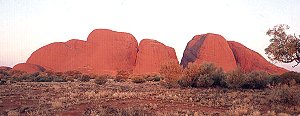

 DARWIN,THE TOP END : Darwin
the capital of the Northern Territory's huge 1.3 million square
kilometres of wilderness, was entirely rebuilt after being flattened
by a tropical cyclone in 1974. Its architecture is now a blend
of contrasts with historic stone buildings such as the Old Navy
Headquarters, the 1883 Fannie Bay Jail and Brown's Mart and new
cyclone-proof structures like the MGM Grand Casino. Darwin's other
attractions include a wharf precinct with a fascinating pearling
exhibition; Botanic Gardens whose 34 hectares of tropical vegetation
provides welcome shade from the Top End heat; and the colourful
Thursday night Market on Mindil Beach-a chance to eat satays and
sip a drink beneath a fluorescent sunset. More action-packed spectacles
include bronco-riding and steer wrestling when the rodeo circuit
comes to town; or, journeying 65 kilometres south of town to watch
the daily feeding frenzy of the 'jumping crocodiles' from a boat
on the Adelaide River.
DARWIN,THE TOP END : Darwin
the capital of the Northern Territory's huge 1.3 million square
kilometres of wilderness, was entirely rebuilt after being flattened
by a tropical cyclone in 1974. Its architecture is now a blend
of contrasts with historic stone buildings such as the Old Navy
Headquarters, the 1883 Fannie Bay Jail and Brown's Mart and new
cyclone-proof structures like the MGM Grand Casino. Darwin's other
attractions include a wharf precinct with a fascinating pearling
exhibition; Botanic Gardens whose 34 hectares of tropical vegetation
provides welcome shade from the Top End heat; and the colourful
Thursday night Market on Mindil Beach-a chance to eat satays and
sip a drink beneath a fluorescent sunset. More action-packed spectacles
include bronco-riding and steer wrestling when the rodeo circuit
comes to town; or, journeying 65 kilometres south of town to watch
the daily feeding frenzy of the 'jumping crocodiles' from a boat
on the Adelaide River.
 JEWELS
OF THE NORTH : Kakadu National Park, 250 kilometres
south-east of Darwin, is a 20,000 square kilometre magical kingdom
of forests, flood plains, ancient art and millons of birds. Its
highlights include waterfalls like Jim Jim and Twin Falls, and
Aboriginal rock art sites of extraordinary antiquity, including
Nourlangie and Ubirr Rock. The yellow Waters wetlands must
be seen from a boat in order to appreciate burmbies, magpie geese
and from an appropriate distance, crocodiles. Some visitors rate
the spectacular waterfalls and lush rain-forest of Litchfield
National Park, south of Darwin, as even more fascinating than
Kakadu. Further south, Katherine Gorge National Park, has a series
of stunning sandstone cliffs rising above the Katherine River.
Some 365 Kilometres north of Alice Springs are the Devils Marbles,
an amazing cluster of huge granite boulders which Aborigines once
believed to be the eggs of the legendary Rainbow Serpent.
JEWELS
OF THE NORTH : Kakadu National Park, 250 kilometres
south-east of Darwin, is a 20,000 square kilometre magical kingdom
of forests, flood plains, ancient art and millons of birds. Its
highlights include waterfalls like Jim Jim and Twin Falls, and
Aboriginal rock art sites of extraordinary antiquity, including
Nourlangie and Ubirr Rock. The yellow Waters wetlands must
be seen from a boat in order to appreciate burmbies, magpie geese
and from an appropriate distance, crocodiles. Some visitors rate
the spectacular waterfalls and lush rain-forest of Litchfield
National Park, south of Darwin, as even more fascinating than
Kakadu. Further south, Katherine Gorge National Park, has a series
of stunning sandstone cliffs rising above the Katherine River.
Some 365 Kilometres north of Alice Springs are the Devils Marbles,
an amazing cluster of huge granite boulders which Aborigines once
believed to be the eggs of the legendary Rainbow Serpent.
Rocks of ages : The
beautiful Kata Tjuta (the Olgas) and Uluru (Ayers Rock) lie in
the Uluru-Kata Tjuta National Park,
south-west of Alice Springs. Kata Tjuta, meaning 'many heads;
are a collection of 36 massive stone conglomerate domes situated
some 32 kilometres to the west of Ayers Rock. A walk within the
convoluted landscape between them, to 'the Valley of the Winds',
is a spellbinding excursion. Their European name arose when explorer
Ernest Giles named the largest dome Mount Olga, after a Russian
duchess. However, according to the Aborigines, some of the domes
represent early giants who fed on their people. Uluru (Ayers Rock)
is the largest rock monolith in the world. Six hundred million
years old and almost 10 kilometres around its girth, this giant
berg of sandstone is an Aboriginal sacred site, and in a different
sense, also a 'sacred' site for visitors from all over the world
who make the strenuous climb to the top. Uluru is located 465
kilometres south of Alice Springs by road.
Uluru-Kata Tjuta National Park,
south-west of Alice Springs. Kata Tjuta, meaning 'many heads;
are a collection of 36 massive stone conglomerate domes situated
some 32 kilometres to the west of Ayers Rock. A walk within the
convoluted landscape between them, to 'the Valley of the Winds',
is a spellbinding excursion. Their European name arose when explorer
Ernest Giles named the largest dome Mount Olga, after a Russian
duchess. However, according to the Aborigines, some of the domes
represent early giants who fed on their people. Uluru (Ayers Rock)
is the largest rock monolith in the world. Six hundred million
years old and almost 10 kilometres around its girth, this giant
berg of sandstone is an Aboriginal sacred site, and in a different
sense, also a 'sacred' site for visitors from all over the world
who make the strenuous climb to the top. Uluru is located 465
kilometres south of Alice Springs by road.